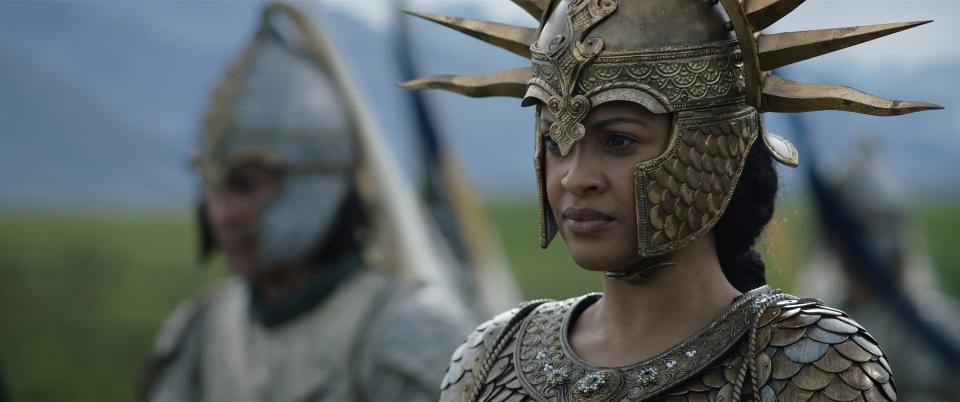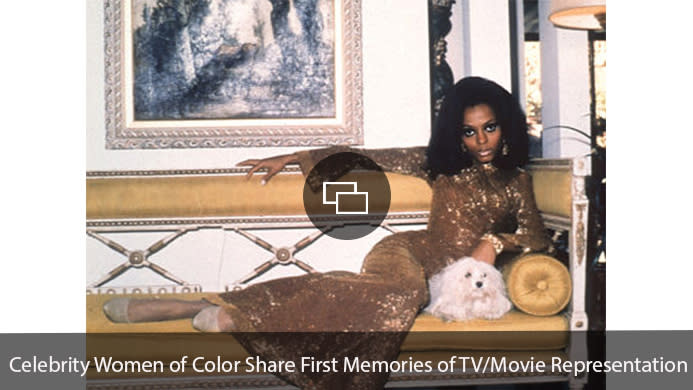'House of Dragon' Take Note: 'Rings of Power' is a Masterclass on Representing Black Women

- Oops!Something went wrong.Please try again later.
With 2022 coming to a close, there has been a wave of Black women representation on both the small and big screen. From AMC’s Interview with the Vampire to Netflix’s SandMan and more, we’ve seen ourselves in a plethora of genres — including, for a rare first time, in the world of fantasy.
However, the influx of Black women’s representation can sometimes feel like a double edged sword. Some movies and shows seem to just be filling a quota rather than actually attempting to make the audience feel seen.
More from SheKnows
This isn’t to say that representation is bad, or not needed. Nowadays, representation for Black women is important. There are tragedies of racial injustice seen daily on the television and sometimes seeing Black people in a fantasy world can feel like an escape.
That said, it is one thing to represent Black characters in complex and well-constructed ways so that respect is given, yet it’s another thing to simply slap Black faces on characters and call it a day. Especially in the case of Black women.
Click here to read the full article.
HBO’s House of the Dragon was anticipated by both newcomers and old fans of Game of Thrones, which aired from 2011-2019.
For Black fans like myself, there was another source of excitement as well, and that came from seeing characters who looked like us. When the trailer dropped and we were introduced to Lords, Ladies, and Valaryians who shared our skin tone, it was revolutionary. Prior to House of the Dragon, prominent Black characters in the franchise were mostly slaves, servants, Dothraki or even Unsullied.
House of the Dragon introduced Black people in positions of royalty. What was even more revolutionary is that the specific Black characters, the Velayrons, are white in the books yet the showrunners made the choice to change their ethnicity.

However, when the show came to its conclusion, I felt it would have been better if Velaryons stayed white in the show, just like their book counterparts. So much of my excitement was overshadowed by disappointment because to me, the Velayrons were not written in to be individuals in their own right. Black faces were slapped onto these characters, and they were — at the end of the day — extremely underwhelming.
Laena (Nanna Blondell), Rhaena (Phoebe Campbell) and Baela (Bethany Antonia) specifically have larger roles in the books. Yet in the television version, it seemed as if they were just there for show. Laena’s relationship with Daemon (Matt Smith) was non-existent and she existed only as a placeholder for Rhaenyra (Emma D’arcy), who was clearly more loved by Daemon. Baela and Rhaena, Daemon and Leana’s children were also pretty much shoved to the side for Rhaenyra and her sons, Jacerys, Lucerys, and Joffrey.
This is in contrast to the books, where these characters are given more control of their narrative and have a far more prominent presence and impact. In the book, Daemon and Laena are in love and happy. In addition, both Laena and Rhaenyra have a very close relationship. Laena is not just a placeholder for Rhaenyra.
Their white counterparts in the book have more agency and prominence to the overall plot. Suddenly, when they are changed to Black in the show, their importance seems to no longer exist. They are disrespected and reduced to serve as plot devices for white characters.
If the writers for House of Dragon want to learn how to create nuanced portrayals of Black characters, they should look no further than Amazon’s Rings of Power.
Similar to House of the Dragon, Rings of Power also portrayed Black women characters in positions of royalty with Disa, the dwarf princess of Khazad – Dum and Tar Míriel, the queen regent of Númenor. Like the characters in George R. R. Martin’s books, Disa and Tar Míriel are white in Tolkien’s books but Black in live action.
This is where the similarities end.
Both Disa (Sophia NomVete) and Tar Míriel (Cynthia Addai-Robinson) are given very intriguing plots and narratives that make them stand out. They do not exist to be placeholders for white characters nor are they reduced; they are integral both to their own narratives and the plot as well.

Disa is a key figure in rekindling the relationship between Elrond (Robert Aramayo) and her husband, Dúrin (Owain Arthur). And as the princess, she acts as an advisor and trusted friend. She is an integral part of the plot and is not simply a Black face on a previously white character. She has her own agency and a well-rounded personality.
Like Disa, Tar Míriel is a fascinating character in her own right.
Her narrative is her own, and her existence as a Black woman is given depth and nuance. She is strong, unbending, and firm in her beliefs yet she is also vulnerable, soft, and understanding. As a Black woman myself, who has seen far too many fall into the ‘strong Black woman trope’, Míriel’s complexity was extremely refreshing. Her motives were clear and like Disa, she was extremely pivotal to the plot.
What Rings of Power managed to do with their Black women characters was give them agency that existed outside of the realms of whiteness and allowed them to have motives of their own. They were not shoved aside nor reduced. Even if their book counterparts were white, the act of changing them to Black characters did not result in the erasure of their presence.
It is not the act of simply putting a Black face on a character, it is making sure to do so with care and nuance. It is helping the audience feel seen rather than just being used.
At the end of the day, any form of Black representation is important. Black characters, especially women represented as royalty in fantasy genres – a genre we are commonly told as Black people we don’t belong in – is revolutionary. However, whether that representation is “good” or “bad” is up to the viewer. Hopefully as we go forward, showrunners understand that representation is more than just slapping faces on characters without giving them depth.
Before you go, click here to see celebrity women of color share the first movie or TV character who made them feel seen.
Best of SheKnows
Sign up for SheKnows' Newsletter.
For the latest news, follow us on Facebook, Twitter, and Instagram.


